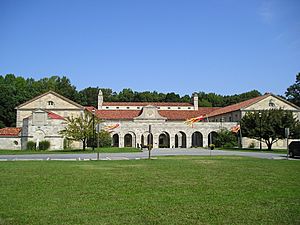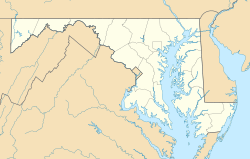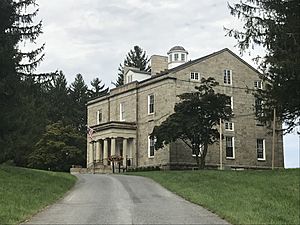Shrine of St. Anthony (Maryland) facts for kids
Quick facts for kids St. Joseph Cupertino Friary |
|
|---|---|
 |
|
| Religion | |
| Affiliation | Catholic Church |
| District | Archdiocese of Baltimore |
| Ecclesiastical or organizational status | Shrine |
| Location | |
| Location | 12290 Folly Quarter Rd Ellicott City, Maryland, United States |
| Architecture | |
| Architect(s) | Benedict Przemielewski, OFM Conv. |
| Architectural type | Friary/Novitate |
| Architectural style | Neo-Renaissance |
| Groundbreaking | 1930 |
| Completed | 1931 |
| Materials | |
|
Carrollton Hall
|
|
| Location | 12290 Folly Quarter Rd., Ellicott City, Maryland |
| Built | 1930-1931 |
| NRHP reference No. | 14001042 |
| Website | |
| www.shrineofstanthony.org | |
The Shrine of St. Anthony is a special Catholic place that honors Saint Anthony of Padua. It's located inside the St. Joseph Cupertino Friary in Ellicott City, Maryland, USA. This shrine is run by the Conventual Franciscan Friars, who are a group of religious brothers.
The friary (which is like a monastery for friars) covers a huge area of about 20,194 square feet on 320 acres of hills and woods. It's a peaceful place for prayer and reflection.
Contents
Visiting the Shrine
The chapel at the shrine holds a special item called a relic of St. Anthony. You can visit the chapel during certain hours. Mass, which is a Catholic church service, happens every day at noon. The shrine also offers other spiritual services like confession, spiritual direction (guidance for your spiritual journey), and special days for prayer.
The grounds around the friary are great for quiet time and prayer. There are seven walking trails and a Lourdes grotto, which is a small cave-like area for prayer. In 2010, a statue of St. Maximilian Kolbe was added to the garden. This statue was even blessed by Pope John Paul II when St. Maximilian Kolbe became a saint!
The historic Manor House is also open to the public on Sundays in October and the first Sunday of November. It has two special rooms that show off its history and often features art exhibits. In 2008, it showed beautiful watercolor paintings and poetry by some of the friars. This building was added to the National Register of Historic Places in 2014 because of its importance.
History of the Shrine's Land
The land where the Shrine of St. Anthony stands has a long history, going back to the Carroll family. In the 1700s, Charles Carroll of Annapolis received a huge piece of land, about 10,000 acres, in what is now Howard County, Maryland. His grandson, Charles Carroll of Carrollton, who was a signer of the Declaration of Independence, later inherited the property.
A part of this large estate, about 1,000 acres, was given to Emily Caton MacTavish, Charles Carroll of Carrollton's granddaughter, as a wedding gift. This new estate was named "Folly Quarter." The main house on this land was designed by William Small and finished in 1832.
Over the years, the property changed hands several times. In 1910, it was bought by Mr. Van Lear Black, who published The Baltimore Sun newspaper. Later, in 1924, Mr. Black sold the house to Mr. Morris Schapiro. Finally, in 1928, Mr. Schapiro sold the house and 236 acres of the estate to the Franciscan Friars.
Building the Friary
The Franciscan Friars bought the property to use as a novitiate, which is a place where new members of a religious order train and learn. The original manor house soon became too small for all the friars. So, one of the friars, Father Benedict Przemielewski, was asked to design a new building.
Father Benedict decided to create a smaller version of the Sacro Convento, which is the very first Franciscan friary built in Assisi, Italy, way back in the 1200s. Construction on the new friary started in 1930 and was finished in 1931. Archbishop Michael Joseph Curley blessed the new building that same year.
Gifts and Recognition
In 1995, the Basilica of Saint Anthony of Padua in Italy gave a very special gift to the shrine: a first-class relic of St. Anthony and a beautiful container for it called a Reliquary. They also sent copies of thirteen original paintings that show important moments in St. Anthony's life.
The Shrine of St. Anthony also offers spaces for groups to come for retreats and hosts an annual pilgrimage (a special journey for religious reasons) in mid-June. This pilgrimage celebrates the Feast Day of St. Anthony of Padua.
On July 1, 2005, William Cardinal Keeler, who was the Archbishop of Baltimore, officially declared the Shrine of St. Anthony to be the main Archdiocesan shrine dedicated to St. Anthony.
Folly Farm House
The Folly Farm house was built in 1730. Around 1800, Charles Carroll made some changes to the house, adding large columns, a round chapel, and a marble bathing pool. This house was given to his granddaughter, Emily Caton MacTavish, to live in while her larger home, Folly Quarter, was being built. Today, the Folly Farm house sits on a seven-acre piece of land.
See also
- List of Howard County properties in the Maryland Historical Trust
- National Register of Historic Places listings in Howard County, Maryland
- Joseph of Cupertino




